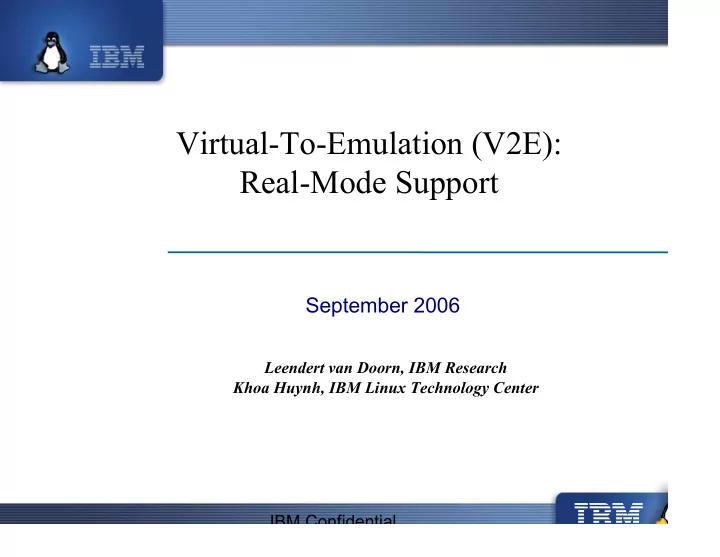

Virtual-To-Emulation (V2E): Real-Mode Support September 2006 Leendert van Doorn, IBM Research Khoa Huynh, IBM Linux Technology Center 1 IBM Confidential
Agenda • Goals and References • Real-mode support with V2E • Current Status • Possible Future Work 2 IBM Confidential
Project Goals • Goals: – Use the concept of “demand emulation” to provide real-mode support for HVM (unmodified) guests • Switch to a full instruction emulator (running in domain 0 inside qemu-dm) for real-mode support • Switch back to HVM guest when in protect mode – A similar concept of “demand emulation” was used for tracking tainted code as described in a Eurosys 2006 paper • Practical Taint-Based Protection using Demand Emulation – Authors: Alex Ho, Michael Fetterman, Christopher Clark, Andrew Warfield, and Steven Hand – This work replaces the existing VMXASSIST code in the hypervisor 3 IBM Confidential
V2E Overview • Adding QEMU instruction emulation code back into QEMU device model (qemu-dm) • Communication between Xen hypervisor and qemu-dm – Transfer HVM context between Xen hypervisor and instruction emulator in qemu-dm • Criteria for switching between Xen hypervisor and qemu-dm 4 IBM Confidential
V2E: Real-Mode Support Instruction Emulator App … App -Full QEMU emulator Device Model CR0.PE=0 Unmodified (VMCALL) -Evtchn interface Guest OS -I/O device model -Call Emulator for EMULATE reqs Evtchn (Shared Domain 0 HVM Guest I/O page) Hypervisor -Invoked when HVM guest enters real-mode (CR0.PE = 0) -Generate EMULATE req and send it to qemu-dm (via evtchn) -Block HVM guest -Restart HVM guest following return from qemu-dm 5 IBM Confidential
QEMU Instruction Emulator • Merge code in ioemu/target-i386 into ioemu/target- i386-dm – Most of the merged code is for handling processor state and instruction emulator initialization (e.g. cpu.h, helper2.c) – Micro operations for i386 are symbolically linked from target-i386 into target-i386-dm • Modify Makefiles to compile instruction emulator code with existing device model – Instruction emulator code requires gcc 3.x – On distros with gcc 4.x, compatibility gcc 3.x package is required • Makefiles & configure files modified to accommodate this 6 IBM Confidential
Hypervisor & qemu-dm • HVM guest enters real mode (CR0.PE is changed to 0 and other Conditions are Met) – Hvmloader vmcall VMX_VMCALL_RESET_TO_REALMODE – Hypervisor is entered (via VM Exit) • Generate an upcall into qemu-dm via event channel – Create new I/O request type: EMULATE – Use shared I/O page (vcpu_iodata) to contain HVM context – Send the EMULATE request to qemu-dm • HVM guest is blocked (hvm_wait_io()) 7 IBM Confidential
Hypervisor & qemu-dm • QEMU-DM receives EMULATE request from hypervisor – EMULATE-type I/O request delivered via event channel – Retrieve HVM context from shared I/O page (vcpu_iodata) – Put HVM context into instruction emulator – Call the main instruction emulator loop to invoke the instruction emulator (cpu_exec()) – Instruction emulator in qemu-dm starts emulating code for HVM guest (i.e., real-mode code and more) 8 IBM Confidential
Hypervisor & qemu-dm • When do we exit instruction emulator in qemu-dm and return to hypervisor ? – After executing a translation basic block, the emulator checks to see if • Any of the segment descriptors are in real-mode (vm8086) ? If so, continue with the next basic block • If not, exit the emulator if more than 1,000 basic blocks have been executed – After exiting instruction emulator loop • Save HVM context in shared I/O page (vcpu_iodata) • Generate an event to return to the hypervisor (via event channel) • Hypervisor restarts HVM guest 9 IBM Confidential
Current Status • 32-bit Linux guests – SLES9 SP2 and RHEL3 U5 boot OK – gfxboot (real-mode) works • gfxboot did not work with existing VMXASSIST code – LTP test suite completes successfully • 64-bit Linux guests – 64-bit port is under way • 32-bit Windows guests – Debugging is under way – Need to synchronize device states between hypervisor and instruction emulator in qemu-dm for devices emulated in hypervisor 10 IBM Confidential
Current Status (cont’d) • Current target: Xen 3.0.4 • Current code can be obtained from http://xenbits.xensource.com/ext/xen-unstable-hvm.hg • Merging with latest xen-unstable tree is under way 11 IBM Confidential
Possible Future Work • Extend this work to I/O emulation – Improve efficiency since cost of up-calls into qemu-dm is high – Need to tune switching criteria between qemu-dm instruction emulator and hypervisor – Need to consider SMP issues (e.g. one thread running on emulator while other threads running in HVM guest) – Remove all redundant emulation code in hypervisor 12 IBM Confidential
Recommend
More recommend